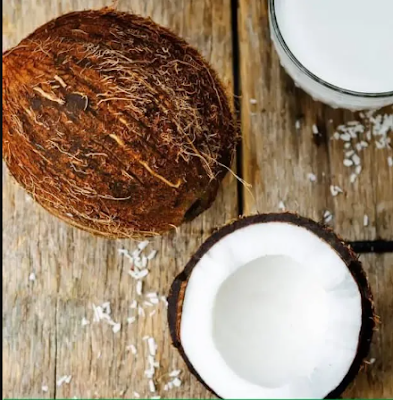Not very many years ago, types of coconuts had supposed links to a range of health problems like heart disease, clogged arteries, and cholesterol increases. This negatively impacted the reputation of all types of coconuts, and people who love the taste were very confused with these claims.
However, there has now been huge amounts of research dedicated to this versatile fruit, and many companies now market it as a miracle food that has dozens of health benefits attached. It’s now a highly demanded food commodity that you’ll see in everything from main dishes and drinks to desserts. Additionally, it’s also a very popular ingredient in skincare and the beauty industry, and many companies market it as a beneficial ingredient to help stop the aging process.
Coconuts come packed with essential vitamins and minerals that can be a huge boost to your physical health, and they can also help your hair and skin look wonderful. We’ve rounded up to 16 most popular types of coconuts on the market for you to consider adding to your diet, and we’ll dive into a short history as well.

Coconut History
The coconut tree is a part of the palm family better known as Arecaceae. When you talk about types of coconuts, you’re referring to the coconut palm that includes the seed and the fruit. Coconut comes from the Portuguese and Spanish word coco, and this loosely translates into skull or head. This name is due to the fact that coconut shells have three indentations in them that make it look like human facial features.
One of the earliest hints of types of coconuts was the story of Sinbad the Sailor called “One Thousand and One Nights” where he brought coconuts and sold them during his fifth voyage. There is also some evidence and records from Sri Lanka’s chronicles that show types of coconuts were around before the 1st Century BCE in South Asia.
Kenneth M. Olsen, a plant evolutionary biologist, noted that there were two origins where the coconut originated from, and it’s the palm Cocos nucifera fruit. These findings heavily imply that the coconut was originally cultivated and brought from two locations, including one in the Indian Ocean basin and one in the Pacific basin.
Genetic records from types of coconuts from ancient civilizations suggest that you could find coconuts on prehistoric trade routes during the colonization period in the Americas. No matter where they come from, you have several different types of coconuts you can choose from today, and we’re going to outline the most popular ones below.
Dwarf Types of Coconuts

If you don’t have a huge amount of space for your coconut tree, a dwarf variety is a nice compromise because they don’t get over 60 feet tall. Coconuts by Amy Truter / CC BY 2.0
The dwarf type of coconut is, as the name suggests, smaller than other entries on the list. They usually get between 20 and 60 feet tall at a maximum, and they can easily ilve between 40 and 50 years. They also start to bear fruit much quicker than the taller types of coconuts. The nuts from the coconuts on the dwarf palms are rounded and much smaller, and they typically weigh in at roughly three ounces. The trees are very susceptible to drought, and they can easily produce orange, green, or yellow-colored types of nuts.
Unlike the taller types of coconuts, the dwarf ones will self-pollinate. So, they don’t have as many variations as other types. They do produce more fruit on average, but the fruit is normally slightly smaller than you’ll get with larger versions of the coconut trees.
Chowghat Orange Dwarf Coconut
This type of coconut will produce very high-quality fruit. When you pick out this coconut plant, you’re going to get a coconut that has a definite orange hue to it. The plant is a very quick producer, and it’s very popular due to the fact that it can produce a large volume of coconuts season after season.
Also, the fruit from this type of coconut tree is quite large, so a single fruit will create a big amount of food to eat. You’ll grow these coconuts in warmer areas around the world, and they can get up to 16 feet tall in India. You will want to stay away from under these types of coconut trees once the fruit starts dropping as the larger size can be dangerous if it were to hit you.
Dwarf Orange Coconut
When you get this type of coconut, it has an average lifespan of roughly 40 years, and the plant grows to around 15 feet at full maturity. It can produce a yellowish-red colored nut that has a rounded shape. It takes between three and four years before it’ll actually start to flower and produce fruit.
The fruit you’ll get with this option has a higher meat content and is very sweet tasting. The average annual yield for a single tree is 63 nuts or palms each year. Additionally, this type of coconut can self-pollinate, and this suggests that it doesn’t have any further variations or types.
Fiji Dwarf
This type of coconut is in very high demand for the fruit and various by-products, and they also make a stunning addition to your landscape. They are one of the more durable coconut varieties you can get, and many people describe them as “one tough nut”. Also, research shows that this coconut has the second highest genetic diversity when you compare it to other types of coconuts.
They are extremely resistant to diseases, and this is a direct contrast to most other tall coconut species. You’ll also get a decently unique leaf structure that sets this choice apart from other coconuts. The leaflets come with much closer spacing that makes them look more rich and lush.
Golden Malayan Dwarf Coconut
As the name suggests, this type of coconut got the name due to the color of the exterior shell. A lot of people mistakenly assume that any coconut they get is going to have a fibrous, brown shell that you see when they add it to your drinks. However, this isn’t what a coconut looks like when it grows on a palm.
You’ll get a very pretty orangish-yellow coloring on the Golden Malayan Dwarf Coconut, and it looks gold in some lighting. The fruit is quite large overall, and a full-sized tree at maturity will be between 50 and 60 feet tall. This makes it on the taller end for a dwarf tree. Another thing that you want to note is that this type of coconut tends to hold onto the flavor and moisture even though this plant is very tolerant to drought conditions.
Green Dwarf Coconut
This type of coconut will easily stand out from other options because it won’t ever turn the darker coloring that you’ve come to expect from the coconut plant. This coconut will stay a bright green color even when it’s ready to get harvested and it’s ripe. This is a very common coconut to see growing in Malaysia. One of the biggest benefits of picking this coconut tree is that the maximum height it can grow to is slightly shorter than the maximum height of other varieties. At the absolute tallest, it won’t get over 30 feet. While this is tall, it’s much more manageable than a 60-foot tree.
One thing you want to remember about this type of coconut is that it tends to produce an impressive amount of coconut water. Also, it’s common to have to work harder to get the meat out of a coconut, and you may need several if you plan on making a coconut-heavy dish because there’s not as much meat. When you decide what plant to choose, make sure to consider the meat and water yield. Since the amount of water and meat each coconut produces varies from type to type, you want to ensure that you pick a fruit that matches your needs.
Hybrid Types of Coconut

Hybrids are mixes of two different plants to help bring out the best of both to make them much more hardy and resistant to diseases. Coconuts by Avinash Bhat / CC BY-SA 2.0
Hybrid types of coconuts are a cross between dual morphological coconut forms and they get produced through two different ways. One way uses a tall female parent and a dwarf male, and the second way uses a tall male parent with a dwarf female. The hybrid coconut has an early flowering and yield compared to others, and they produce excellent fruit when you compare them to the parent varieties. They also perform very well when you give them the correct growing conditions, including nutrient management and the correct watering schedule.
Chandrakala Coconut
This is a very high-volume and fast-producing coconut tree. If you’re going to start growing types of coconuts to sell, this species may leave you pleasantly surprised by how much fruit you get from a single tree. The average tree will give you well over 100 coconuts each year. However, if you don’t have the correct tools on hand, you’re going to have a hard time getting the meat and water out of the fruit.
Another nice point with this type of coconut is that it’s very easy to grow. The tree is very tolerant of sandy soil conditions, and the soil you have doesn’t have a direct impact on how much fruit it produces. However, you do want to ensure that you put the tree in a place where it gets full sun if you want to get the best tasting and largest coconuts possible. For areas where the temperatures tend to fluctuate, this is becoming one of the most popular coconut trees to grow because it’s hardy.
Malayan Yellow Dwarf Coconut
This is another hybrid type of coconut that offers very high yields, and they do best when you grow them in tropical locations. They usually need a free-draining soil with a very deep layer of organic mulch in the surrounding areas to encourage nice growth. This is believed to be one of the most widespread hybrid dwarf coconut trees in the world, and it came to Malaysia between 1890 and 1900 via Indonesian planters.
When this type of coconut is younger, the fruit will have a very pale greenish-yellow shade. As they age, the leaf stalk’s coloring, fruit, and the seeding sprouts will turn a pale yellow. This variety of coconut is commonly grown in several different countries, including India, Fiji, Thailand, Jamaica, and Brazil. They will typically give you medium-sized fruits that weigh between 700 and 800 grams.
Maypan Coconut
This type of coconut originally comes from Jamaica, and you may hear it called the sturdy coconut. It falls into the hybrid coconut category, and it is grown because the crossbreeding has allowed it to be very resistant to Lethal Yellowing, and this is a disease that attacks different palm species.
These coconuts are also engineered to be exceptionally hardy against the cold, and it can do well in adverse growing conditions. It’s a large to medium-sized coconut tree that will get roughly 54 feet tall at full maturity. It grows best in areas that stay above 40°F all year round.
VHC1 Coconut
As the name may suggest, this type of coconut isn’t one that you could find growing naturally anywhere in the world. A lot of scientists will take multiple plants and crossbreed them. The goal of this cross breeding process is to try and make fruit that tastes better with more meat and a higher water content. Sometimes, the scientists do this to try and make a coconut tree more tolerant to heavy rains or more drought-resistant.
This coconut is a mix between the Green Dwarf type of coconut and the East Coast Tall Coconut plant. The reason why they crossbred the Green Dwarf and East Coast Tall coconuts is to increase the fruit yield per year. Generally speaking, anything over 50 coconuts per plant per year is considered to be a lot, but this one can produce nearly 100 coconuts each year. This is usually more than enough for your needs.
Sub-Grouped Types of Coconuts
The coconut palm (Cocos nucifera) is a palm tree that produces a single coconut. But, you can find several types cultivated and grown in multiple countries. The sub-varieties may vary significantly in terms of coconut water content and taste, as well as the coloring of the fruit. It’s also possible to find several slight color variations in the genetic factors. Some of the most popular and common types of coconuts that fall into this category are below.
Golden Malay Coconut
This type of coconut is usually grown throughout Bulgaria, and it gets imported straight from Indonesia. This is a palm tree that produces a very pretty red to bronze-colored fruit, and they grow best when you grow them outside of the tropics in a warm and sheltered spot. They also require a decent amount of organic mulch in the area around them, and the soil should drain freely.
The average height for this type of coconut is around 36 feet, and the spread or width is between 24 and 36 feet. So, this is a very wide plant. As a bonus, this tree will start producing a decent amount of fruit very early, and the fruits come with a very ornamental and pretty orangish-gold coloring. They also produce great quality drinking water and the fruit content works wonderfully for cooking.
King Coconut
Native to India and Sri Lanka, this type of coconut is slightly shorter than most other varieties on the list. On average, this palm tree will get roughly 60 feet tall and produce clusters of 20 nuts. The nuts have a football shape to them, so they look like elongated ovals. The skin will come with a very bright orange tint to it. You can get this coconut all year round, and they get harvested every seven to eight months. The nuts give you a very flavorful and sweet liquid that is very refreshing and cooling.
This type of coconut gives you a very rich nutritional addition to any dish, and it’s a big source of amino acids, vitamins, potassium, sodium, chloride, and phosphate. The liquid inside of these coconuts has a higher potassium level than you’ll get from a banana. They also have bioactive enzymes that help boost your metabolism and help with digestion. You’ll primarily use this coconut for the milk and the liquid inside of the rinds.
Macapuno Coconut
Better known as the kopyor coconut, this type of coconut is a dwarf mutant species. However, it’s a naturally-occuring coconut that gives you a jelly-like, soft flesh due to the endosperm’s abnormal development. This gives you an undernourished embryo called a collapsed embryo. Even though this type of coconut offers virtually the same nutritional content as you’ll get with a regular or normal coconut, the abnormal development gives it a different type of shell that has virtually no liquid and gelatinous coconut meat.
This abnormality is why you won’t find this coconut in a lot of countries. However, it’s considered to be a sweet delicacy in Asia, and it’s popular in a range of desserts and sweets that get sold at a much higher price point compared to the ones that use traditional coconut. The texture is firm but soft, and they have a very nutty and pleasant taste. There is a decent amount of protein and oils, and this makes them a very nice food source.
Tall Types of Coconuts

When most people think of coconut trees, they think of the very tall varieties that tower 100+ feet in the air. They usually live for decades and produce a large amount of fruit each year. Coconuts by Pablo Ricco / CC BY-NC-ND 2.0
The tall types of coconuts are some of the most common to grow, and the two most popular types in this category are the West Coast Tall and the East Coast Tall. They live between 80 to 90 years on average, and they can grow to an altitude of 3,000 feet. This puts them well above sea level, and they typically get between 50 and 65 feet tall at full maturity.
The tall types of coconut trees do well under different soil conditions than most coconuts, and they love littoral sands and red loams. They’re decently resistant to diseases and pests, and the nut is a medium to large-size. They often have a range of colors associated with them, including hues of green, yellow, brown, and orange. They can cross-pollinate too, and this suggests that they’ll share genetic material with other trees. This means you’ll get more variations in terms of the coconut’s characteristics.
East Coast Tall Coconut Tree
As you may have guessed, the tall types of coconut trees tower over the dwarf varieties. If you thought that it was hard to reach a coconut that was only 30 feet up off of the ground, try reaching something that is up to 90 feet high. These very tall palm trees require full, direct sun exposure each day and a lot of room around them. This particular tree will start to produce fruit after it grows for six to seven years, and you can easily get upwards of 60 coconuts per tree each year.
Jamaican Tall
As the name tells you, this tree originated in Jamaica, and they’re very similar to the West Coast Tall as they get just over 100 feet high at full maturity. One of the important things that makes this pick stand out is the amount of coconuts you get from a single tree each year. A more mature and older tree in this category can easily produce upwards of 200 coconuts every year. This is much more than a single family can eat or use, and this is what makes them popular for neighborhoods or businesses where everyone works to keep everyone fed.
These trees can live up to 80 years under the correct growing conditions, and they produce at this level each year. So, if you’re looking to enjoy a huge amount of coconuts every year for a few decades, you should consider adding this type of coconut tree to your space.
Tiptur Tall
Originating in India, this type of coconut has a very low-maintenance schedule. Generally speaking, this tree will do very well by itself without a lot of input from you. You will need to monitor them for any disease growth though. This is exactly why so many crossbreeds are now available to help ensure that you create more stable and stronger trees. You’ll usually get between 70 and 80 coconuts per year with this tree, and it typically gives you the same amount year in and year out.
It’s very easy to grow in the fact that all you have to do is fertilize it and leave it alone. Once you get them set up, they’ll faithfully produce crops. The fruit this type of coconut tree produces is like a traditional coconut with a medium amount of meat and water inside. You’ll want to put it in a place that gets full sun each day with medium moisture levels to help keep it healthy and producing fruit.
West Coast Tall Coconut
Finally, this type of coconut tree will do very well in any area where you need more height and it’s open so they can get all of the sun they want. You’ll see even more height with this pick than the East Coast Tall, and it can get upwards of 100 feet in the air at full maturity. Also, it has a much higher oil content per fruit to make it more nutritionally-dense.
The difference between this tree and others is the characteristics and height you get. The consistency will also change the way this coconut tastes. The water content is around the average amount a traditional coconut offers, and the meat has more oil. Any products made with coconut oil will do well with this type.
Bottom Line
We’ve outlined 16 types of coconut and broke them down into several categories for you to consider. If you’re in a location with favorable growing conditions, you may want to consider adding one or two coconut trees to your landscape to enjoy this healthy fruit whenever you want.
Source: happydiyhome








![The Statesman’s Return — OGD in the Senate and the Rebirth of Strategic National Leadership [Part 5]](https://newsheadline247.com/wp-content/uploads/2024/07/Gbenga-Daniel-newsheadline247_1-218x150.jpeg)
![Quiet Reforms, Stronger Intelligence: Inside the DSS’ Reorganisation Drive [FEATURE]](https://newsheadline247.com/wp-content/uploads/2025/11/DSS-596x340-2-218x150.jpg)
![FEATURE: The Political Dimension — How OGD Redefined Leadership and Governance in the Southwest [Part 4]](https://newsheadline247.com/wp-content/uploads/2025/11/Otunba-Gbenga-Daniel-newsheadline247-291x300-1-218x150.jpg)
![Legacy in Continuity: How Gbenga Daniel’s Vision Still Shapes Ogun State’s Development [Total Recall Part 3] newsheadline247/Gbenga Daniel](https://newsheadline247.com/wp-content/uploads/2019/03/newsheadline247-Gbenga-Daniel-e1553985504695.jpg)
![FEATURE: The Human Side of OGD’s Governance: How Gbenga Daniel Rewrote Ogun’s Social and Educational Story [Part 2]](https://newsheadline247.com/wp-content/uploads/2025/09/Otunba-Gbenga-Daniel-newsheadline247-218x150.webp)















